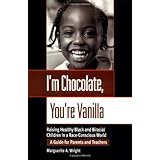
Average Reviews:

(More customer reviews)The book covers a lot of ground. But as a father of a biracial son the most relevant parts for me dealt with light-skinned and biracial children. An important theme of the book is "Don't racialize childhood": Young children should be shielded from our adult racial baggage for as long as possible. Wright believes that early teaching about race and racism tends to result in black children feeling needlessly powerless and confused about their place in this world.
Wright encourages parents to raise older children in such a manner as to teach that integration and educational success are fully consistent with "being authentically black." On this important issue, she encourages parents to become aware and resist notions of black identity that rest on longstanding white racist stereotypes that have been internalized by many African Americans. For example, successful blacks (particularly successful black men) are often derided as "oreos" or "sell-outs."
Sometimes Wright seems to downplay the degree to which residual white supremacy continues to constrict the lives of black children. For example, regarding the classic issue of black "self hatred," she argues that it is rare for young black children to be ashamed of themselves or their race unless they have been abused or explicitly taught racist attitudes by caregivers. On this point, her position differs somewhat from social psychological research that argues that black kids identify with whites because whites simply have more power, wealth, and social status in American society. Yet, I believe Wright is correct when she encourages parents not to get too bent out of shape if their child goes through a stage in which he or she insists that he or she is white. As she shows in her excerpts from interviews with preschoolers, young children might use racial language, but they do not have an adult understanding of race. For example, preschoolers do not know about the one-drop rule, and it is typical for light-skinned children to believe for a time that they are white, as they are aware that their skin tone is similar to that of whites. This does not mean they hate blacks or think they are better than darker blacks. Wright explains that many black parents needlessly feel rejected when light-skinned children assert that they are white-this is usually a developmental stage, not a political or emotional rejection of blackness.
The author feels that parents and other caregivers can buffer most of the negative effects of white racism during the important early years. However, she argues (correctly, in my opinion) that poorly funded inner city public schools threaten to undo much of parents' best effort to prepare black children to compete in the larger society. Hence, she makes a compelling argument for school choice/vouchers and encourages parents to be ever vigilant in the education of their children.
Wright shows her integrity when she boldly speaks out against injustice within the black community. For example, she denounces the cynicism of African American special interest groups (e.g., NAACP) who seek to use the racist and oppressive "one-drop rule" to suppress biracial or multiracial identity.(It is simply wrong for mixed children to be expected to "closet" any part of their family heritage!)
Noting the increasing nihilism among black youth, Wright warns that parents and teachers need to teach and model the Golden Rule, something she believes that many in the black community have drifted away from. And she does not shy away from identifying a series of behavioral issues that undermine the health of black children, such as hurtful color biases within the black community (including overt favoritism of females with "good" hair), high rates of teenage and single parentage, a tendency to mistake dehumanizing forms of physical and emotional abuse for "discipline," and overly permissive attitudes regarding exposure to high doses of commercial TV and misogynistic and brutal music lyrics (i.e., Gansta rap).
All in all, this is a well-written and balanced book written by a committed mother and psychologist.
Click Here to see more reviews about: I'm Chocolate, You're Vanilla: Raising Healthy Black and Biracial Children in a Race-Conscious World

0 comments:
Post a Comment